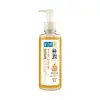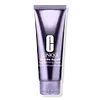What's inside
What's inside
 Key Ingredients
Key Ingredients

 Benefits
Benefits

 Concerns
Concerns

 Ingredients Side-by-side
Ingredients Side-by-side

Water
Skin ConditioningButylene Glycol
HumectantSodium Myristoyl Glutamate
CleansingSorbitol
HumectantSodium Methyl Cocoyl Taurate
CleansingSodium Lauroyl Glutamate
Cocamide DEA
EmulsifyingMyristic Acid
CleansingGlyceryl Stearate
EmollientSodium Chloride
MaskingLauric Acid
CleansingPEG-40 Hydrogenated Castor Oil
EmulsifyingPolyglyceryl-2 Isostearate
EmulsifyingPolyquaternium-7
Methylparaben
PreservativeSodium Acetylated Hyaluronate
HumectantHydroxypropyltrimonium Hyaluronate
Water, Butylene Glycol, Sodium Myristoyl Glutamate, Sorbitol, Sodium Methyl Cocoyl Taurate, Sodium Lauroyl Glutamate, Cocamide DEA, Myristic Acid, Glyceryl Stearate, Sodium Chloride, Lauric Acid, PEG-40 Hydrogenated Castor Oil, Polyglyceryl-2 Isostearate, Polyquaternium-7, Methylparaben, Sodium Acetylated Hyaluronate, Hydroxypropyltrimonium Hyaluronate
Water
Skin ConditioningMyristic Acid
CleansingGlycerin
HumectantSodium Methyl Cocoyl Taurate
CleansingPotassium Hydroxide
BufferingLauric Acid
CleansingBehenic Acid
CleansingPPG-24-Glycereth-24
EmulsifyingSodium Hyaluronate
HumectantSodium Acetylated Hyaluronate
HumectantButylene Glycol
HumectantCaprylyl Glycol
EmollientGlycol Distearate
EmollientPolyquaternium-7
Hexylene Glycol
EmulsifyingTetrasodium EDTA
Phenoxyethanol
PreservativeSodium Benzoate
MaskingCI 60730
Cosmetic ColorantWater, Myristic Acid, Glycerin, Sodium Methyl Cocoyl Taurate, Potassium Hydroxide, Lauric Acid, Behenic Acid, PPG-24-Glycereth-24, Sodium Hyaluronate, Sodium Acetylated Hyaluronate, Butylene Glycol, Caprylyl Glycol, Glycol Distearate, Polyquaternium-7, Hexylene Glycol, Tetrasodium EDTA, Phenoxyethanol, Sodium Benzoate, CI 60730
 Reviews
Reviews

Ingredients Explained
These ingredients are found in both products.
Ingredients higher up in an ingredient list are typically present in a larger amount.
Butylene Glycol (or BG) is used within cosmetic products for a few different reasons:
Overall, Butylene Glycol is a safe and well-rounded ingredient that works well with other ingredients.
Though this ingredient works well with most skin types, some people with sensitive skin may experience a reaction such as allergic rashes, closed comedones, or itchiness.
Learn more about Butylene GlycolLauric Acid is a fatty acid or lipid. About half of fatty acids in coconut oil is lauric acid.
This ingredient helps hydrate and sooth skin. As a humectant, it helps trap moisture. It also aids in cleaning and enhancing the texture of products.
Lauric acid may not be Malassezia folliculitis, or fungal acne, safe.
Learn more about Lauric AcidMyristic Acid is a saturated fatty acid. It is naturally found in milk fat. Other sources include palm oil, coconut oil, and butter fat.
Myristic Acid is an emulsifer and cleanser. As an emulsifer, it stabilizes a product by preventing ingredients from separating. Myristic Acid helps clean your skin by acting as a surfactant. It tends to gather oil and dirt on your skin to be easily rinsed away.
One study from 2021 found Myristic Acid to have anti-inflammatory properties.
Learn more about Myristic AcidPolyquaternium-7 is a light to clear colored liquid. It is commonly found in haircare products for its film-forming and anti-static properties.
According to a manufacturer, it is a non-paraben and specially developed for negatively charged surfactant systems. This makes it a great hairstyle holder and helps to improve wet hair detangling without adding buildup.
Sodium Acetylated Hyaluronate is a type of Hyaluronic Acid.
Hyaluronic Acids help moisturize, soothe, and protect the skin.
Read about common types of Hyaluronic Acid here:
Sodium Hyaluronate
Hydrolyzed Hyaluronic Acid
Hyaluronic Acid
This gentle cleansing and foaming ingredient is known for leaving a smooth feeling in skin and hair. It is made using coconut oil.
According to the manufacturer, it is soluble in water and has resistance to hard water, acid, and alkali.
Due to its coconut base, it may not be Malassezia folliculitis safe.
Learn more about Sodium Methyl Cocoyl TaurateWater. It's the most common cosmetic ingredient of all. You'll usually see it at the top of ingredient lists, meaning that it makes up the largest part of the product.
So why is it so popular? Water most often acts as a solvent - this means that it helps dissolve other ingredients into the formulation.
You'll also recognize water as that liquid we all need to stay alive. If you see this, drink a glass of water. Stay hydrated!
Learn more about Water